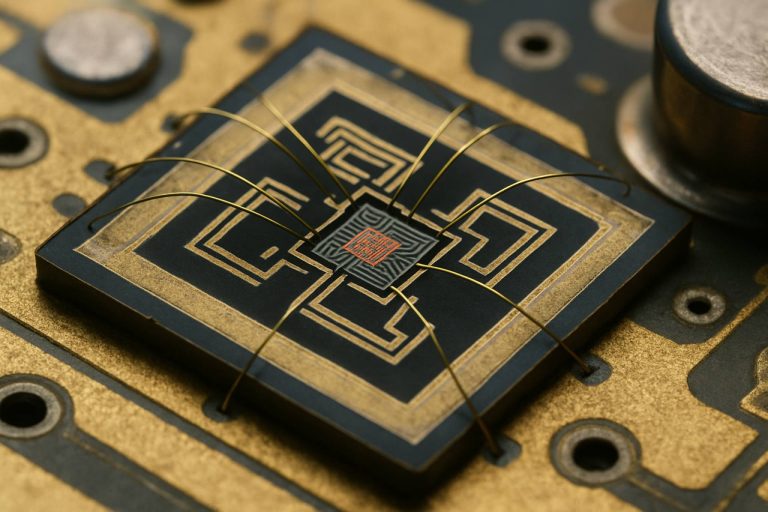
Unlocking the Power of Graphene Plasmonics: How This Quantum Marvel Is Transforming Photonics, Sensing, and Next-Gen Electronics
- Introduction: What Are Graphene Plasmonics?
- The Science Behind Plasmons in Graphene
- Breakthrough Applications: From Ultra-Fast Communications to Biosensing
- Advantages Over Traditional Plasmonic Materials
- Recent Research Highlights and Milestones
- Challenges and Limitations in Graphene Plasmonics
- Future Prospects: Toward Quantum Devices and Beyond
- Conclusion: The Road Ahead for Graphene Plasmonics
- Sources & References
Introduction: What Are Graphene Plasmonics?
Graphene plasmonics is an interdisciplinary field that explores the interaction between electromagnetic waves and collective oscillations of charge carriers—known as plasmons—in graphene, a single layer of carbon atoms arranged in a hexagonal lattice. Unlike traditional plasmonic materials such as noble metals, graphene offers unique advantages, including tunable plasmon frequencies, high confinement of electromagnetic fields, and low losses in the terahertz to mid-infrared spectral range. These properties stem from graphene’s exceptional electronic structure and its two-dimensional nature, which allow for dynamic control of plasmonic behavior via electrical gating or chemical doping Nature Photonics.
The field of graphene plasmonics has rapidly advanced since the first experimental demonstrations of graphene-supported surface plasmons. Researchers have shown that graphene plasmons can be confined to volumes much smaller than the wavelength of light, enabling strong light-matter interactions at the nanoscale Science Magazine. This capability opens up new possibilities for applications in photodetectors, modulators, biosensors, and even quantum information technologies. Furthermore, the ability to tune plasmonic resonances in real time distinguishes graphene from conventional plasmonic materials, making it a promising platform for reconfigurable and multifunctional optoelectronic devices Nature.
Overall, graphene plasmonics represents a convergence of nanophotonics, materials science, and condensed matter physics, offering a versatile toolkit for manipulating light at the nanoscale and paving the way for next-generation photonic and optoelectronic technologies.
The Science Behind Plasmons in Graphene
Plasmons in graphene arise from the collective oscillations of its conduction electrons, which can be excited by incident electromagnetic fields. Unlike plasmons in conventional metals, graphene plasmons are highly tunable due to the material’s unique two-dimensional structure and linear energy-momentum relationship. This tunability is primarily achieved through electrostatic gating or chemical doping, allowing precise control over the plasmon resonance frequency across the terahertz to mid-infrared spectral range Nature Photonics.
The confinement of plasmons in graphene is exceptionally strong, with wavelengths much shorter than the incident light, leading to significant field enhancement and subwavelength localization. This property is attributed to graphene’s high carrier mobility and low electronic losses, which enable long plasmon lifetimes compared to traditional plasmonic materials Science. The dispersion relation of graphene plasmons is also distinct, exhibiting a square-root dependence on carrier density and wavevector, which is a direct consequence of its Dirac-like electronic structure.
Furthermore, the interaction of graphene plasmons with phonons, defects, and substrate materials can lead to hybridized modes and additional tunability, opening avenues for novel optoelectronic applications. The ability to dynamically modulate plasmonic properties in situ makes graphene a promising platform for next-generation photonic and sensing devices Nature.
Breakthrough Applications: From Ultra-Fast Communications to Biosensing
Graphene plasmonics has rapidly advanced from fundamental research to a platform enabling breakthrough applications across diverse fields. One of the most promising areas is ultra-fast optical communications. Graphene’s ability to support highly confined, tunable plasmons at terahertz and mid-infrared frequencies allows for the development of modulators and photodetectors with unprecedented speed and miniaturization. These devices can operate at bandwidths far exceeding those of conventional semiconductor technologies, paving the way for next-generation data transmission systems with ultra-high capacity and low energy consumption (Nature Photonics).
In biosensing, graphene plasmonics offers exceptional sensitivity due to the strong field confinement and the material’s atomic thickness. Plasmonic resonances in graphene can be tuned via electrostatic gating, enabling real-time, label-free detection of biomolecules at extremely low concentrations. This tunability, combined with graphene’s chemical stability and biocompatibility, has led to the development of sensors capable of detecting viruses, proteins, and even single molecules, with potential applications in medical diagnostics and environmental monitoring (Science).
Beyond communications and biosensing, graphene plasmonics is also being explored for applications in photodetection, imaging, and quantum information processing. The integration of graphene with other two-dimensional materials and photonic structures further expands its functionality, enabling hybrid devices with tailored optical responses. As fabrication techniques mature, the translation of these laboratory breakthroughs into commercial technologies is becoming increasingly feasible, heralding a new era of plasmonic devices with transformative impact (Nature Reviews Materials).
Advantages Over Traditional Plasmonic Materials
Graphene plasmonics offers several compelling advantages over traditional plasmonic materials such as gold and silver, particularly in the terahertz to mid-infrared spectral ranges. One of the most significant benefits is the high degree of tunability. The plasmonic response of graphene can be dynamically controlled via electrostatic gating, chemical doping, or optical pumping, enabling real-time modulation of plasmon resonance frequencies—an ability largely absent in conventional metals Nature Photonics.
Another key advantage is the exceptionally strong field confinement. Graphene plasmons can be compressed to volumes much smaller than the diffraction limit, resulting in enhanced light-matter interactions and increased sensitivity for sensing applications Science. Additionally, graphene exhibits relatively low plasmonic losses in the relevant frequency ranges, especially when compared to noble metals, which suffer from significant ohmic losses at optical frequencies Nature Materials.
Graphene’s two-dimensional nature also allows for seamless integration with other nanomaterials and flexible substrates, paving the way for novel device architectures in photonics and optoelectronics. Furthermore, the compatibility of graphene with standard semiconductor processing techniques facilitates scalable fabrication and integration into existing technologies Nature Nanotechnology.
In summary, the unique electronic properties, tunability, and integration potential of graphene make it a superior platform for next-generation plasmonic devices, surpassing many limitations of traditional metallic plasmonic materials.
Recent Research Highlights and Milestones
Recent years have witnessed significant advances in the field of graphene plasmonics, driven by the material’s unique ability to support highly confined, tunable surface plasmons in the terahertz to mid-infrared spectral range. One major milestone was the experimental demonstration of tunable graphene plasmons using electrostatic gating, which enabled dynamic control over plasmon resonance frequencies and propagation lengths, as reported by Nature. This tunability has opened new avenues for active plasmonic devices, such as modulators and sensors.
Another key development is the integration of graphene with photonic and plasmonic nanostructures, leading to hybrid systems with enhanced light-matter interactions. For instance, coupling graphene with metallic nanoantennas has resulted in strong plasmonic enhancement and improved device performance, as highlighted by Science. Additionally, the realization of ultra-confined acoustic plasmons in graphene/hBN heterostructures has pushed the boundaries of subwavelength optics, enabling manipulation of light at the nanometer scale (Nature).
Recent research has also focused on the development of low-loss graphene plasmonic waveguides and the demonstration of room-temperature plasmonic devices, which are crucial for practical applications in optoelectronics and sensing (Nature). Collectively, these milestones underscore the rapid progress and transformative potential of graphene plasmonics in next-generation photonic technologies.
Challenges and Limitations in Graphene Plasmonics
Despite the remarkable potential of graphene plasmonics for applications in sensing, photodetection, and optoelectronics, several challenges and limitations hinder its widespread adoption. One of the primary obstacles is the relatively high plasmonic losses in graphene, especially at room temperature, which stem from electron-phonon and electron-impurity scattering. These losses reduce the quality factor of graphene plasmons, limiting their propagation length and practical utility in devices Nature Photonics.
Another significant challenge is the fabrication of high-quality, large-area graphene with minimal defects and uniform doping. Imperfections in graphene sheets, such as grain boundaries and wrinkles, can scatter plasmons and degrade device performance. Moreover, achieving precise and reproducible control over the Fermi level—essential for tunable plasmonic response—remains technically demanding, particularly in scalable device architectures Materials Today.
Integration with existing photonic and electronic platforms also presents difficulties. The strong confinement of graphene plasmons requires nanometer-scale patterning, which is challenging with current lithography techniques. Additionally, the mid-infrared to terahertz operational range of graphene plasmons, while advantageous for certain applications, limits their use in visible and near-infrared regimes where many commercial technologies operate Optica.
Addressing these challenges will require advances in material synthesis, device engineering, and hybrid integration strategies to fully exploit the unique properties of graphene plasmonics in practical applications.
Future Prospects: Toward Quantum Devices and Beyond
The future of graphene plasmonics is poised to revolutionize quantum device engineering and beyond, leveraging the material’s unique electronic and optical properties. Graphene’s ability to support highly confined, tunable plasmons at room temperature opens avenues for integrating plasmonic functionalities into quantum information processing, single-photon sources, and ultra-sensitive detectors. The strong light-matter interaction in graphene enables the manipulation of quantum states at the nanoscale, which is essential for scalable quantum technologies. Recent advances suggest that hybrid systems, combining graphene with other two-dimensional materials or quantum emitters, can further enhance plasmonic coupling and coherence times, critical for quantum communication and computation applications (Nature Reviews Materials).
Looking ahead, the development of electrically tunable and low-loss graphene plasmonic devices could lead to breakthroughs in on-chip quantum photonics, including compact modulators, switches, and entangled photon sources. Moreover, the integration of graphene plasmonics with silicon photonics and superconducting circuits is expected to bridge the gap between classical and quantum platforms, enabling hybrid quantum systems with unprecedented performance (Science). Challenges remain, such as mitigating plasmonic losses and achieving large-scale, reproducible fabrication, but ongoing research in material engineering and device architecture continues to push the boundaries. Ultimately, graphene plasmonics holds the promise of enabling next-generation quantum devices, sensors, and communication systems, marking a transformative step in both fundamental science and practical technology.
Conclusion: The Road Ahead for Graphene Plasmonics
Graphene plasmonics stands at the forefront of nanophotonics, offering unprecedented control over light-matter interactions at the nanoscale. The unique tunability, high confinement, and low-loss characteristics of graphene plasmons have already enabled significant advances in terahertz and mid-infrared photonics, biosensing, and optoelectronic devices. However, several challenges remain before the full potential of graphene plasmonics can be realized in commercial technologies. Key issues include scalable and reproducible fabrication of high-quality graphene, integration with existing photonic platforms, and the development of robust methods for dynamic plasmon tuning and loss mitigation.
Looking ahead, interdisciplinary research combining materials science, device engineering, and theoretical modeling will be crucial. The integration of graphene with other two-dimensional materials and metamaterials may unlock new functionalities, such as active modulation and non-linear optical effects. Furthermore, advances in large-area graphene synthesis and patterning techniques are expected to accelerate the transition from laboratory demonstrations to real-world applications. The exploration of hybrid systems, where graphene plasmons interact with quantum emitters or other nanostructures, could pave the way for breakthroughs in quantum information processing and ultra-sensitive detection.
Ultimately, the road ahead for graphene plasmonics is both challenging and promising. Continued investment in fundamental research and collaborative efforts between academia and industry will be essential to overcome current limitations and harness the extraordinary properties of graphene for next-generation photonic and optoelectronic technologies. For further insights, see resources from the Nature Publishing Group and the Optica (formerly OSA).



